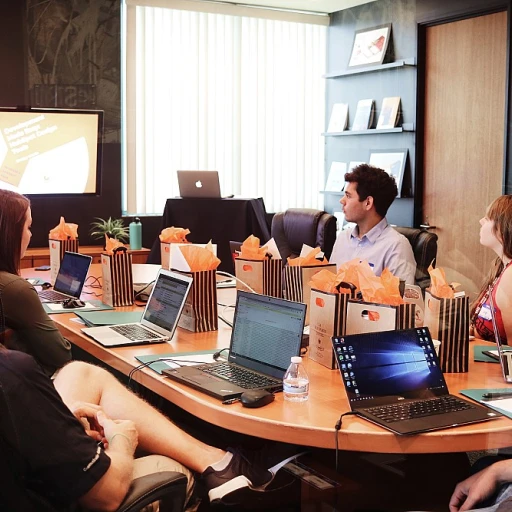
Understanding Integrated Talent Management
The Essence of a Holistic Approach
Integrated talent management serves as a comprehensive approach that aligns various elements of talent acquisition, development, and retention to foster business success. It is not merely about managing individual components such as performance or succession planning in isolation, but rather combining all these processes into a cohesive strategy.
The core concept of integrated talent management revolves around aligning the development of employees with the strategic goals and objectives of the organization. This approach enhances employee engagement and the overall performance of the workforce by ensuring that each aspect of human resources management is interconnected and aligned with the overall management strategy.
The management framework integrates key elements like learning and development, performance management, and workforce planning into a seamless process that encourages continuous learning and skill enhancement. Such systems are designed to respond dynamically to the changing demands of the business environment, thereby fostering a culture of adaptability and improvement among the workforce.
Organizations that effectively implement integrated talent strategies can identify skill gaps, enhance their talent acquisition processes, and ensure that employees are equipped with the necessary training to meet evolving business needs. By aligning these components, businesses can optimize their talent management efforts to achieve strategic objectives and sustain competitive advantage.
Ultimately, the integrated talent management model can drive better talent outcomes by creating a synergistic environment where all elements of people management work together to support the growth and development of both employees and the organization as a whole.
The Role of Integrated Talent Management in Reskilling
The Strategic Contribution of Talent Management in Reskilling
Reskilling is more than just a momentary adjustment—it's an overarching strategy that can propel organizations towards their goals through coordinated talent management. As businesses navigate through rapid market changes and technological advancements, it’s crucial to view reskilling through the lens of integrated talent management. This involves making informed decisions that align with business objectives and developing a robust framework for sustained employee development and growth.
Incorporating integrated talent management into reskilling strategies offers several key benefits:
- Comprehensive Workforce Planning: By embracing a holistic management system, organizations can proactively identify skills gaps and anticipate future needs. This involves not only analyzing current performance metrics but also evaluating economic trends and industry shifts to ensure the workforce is prepared for upcoming challenges.
- Enhanced Employee Engagement: Engaging employees in their personal development boosts morale and productivity. A structured learning development process fostered by integrated talent strategies allows employees to take charge of their career paths, which can lead to increased job satisfaction and reduced turnover rates.
- Seamless Succession Planning: Organizations can build a talent pipeline by equipping employees with the skills necessary to step into critical roles. This ensures leadership continuity and mitigates the risks associated with losing key personnel unexpectedly.
Effective reskilling initiatives don’t exist in a vacuum; they are intertwined with the broader talent management framework. The collaboration of human resources, management systems, and talent development programs is vital to meet the evolving needs of the business and stay competitive. By doing so, companies are not only investing in their workforce but also laying the groundwork for future success.
For more insights into empowering workplace aspirations through reskilling, visit this detailed guide.
Identifying Skills Gaps and Needs
Bridging the Skills Divide
Identifying skills gaps and needs is a fundamental aspect of any effective reskilling strategy. This process focuses on understanding where your organization is currently standing in terms of employee skills and where it aims to be in the future. An integrated approach to talent management plays a crucial role in achieving this. Skills gap analysis is key to ensuring that an organization's workforce is aligned with its strategic goals. This process involves assessing the current skills within the organization and comparing them to the future skills required. By doing this, organizations can clearly identify which areas need improvement and development. Moreover, the involvement of both employees and management is essential in this analysis stage. A collaborative approach between human resources and department leaders can provide a comprehensive overview of where skill deficiencies exist. In addition, engaging employees in this process encourages a culture of continuous learning and development, fostering greater employee engagement and retention. To facilitate this analysis, integrated talent management systems can be employed. These systems help streamline the information-gathering process by providing a centralized platform where skill assessments and performance metrics can be reviewed and analyzed. This data-driven approach ensures that organizations can make informed decisions about which skills to focus on during reskilling initiatives. Furthermore, workforce planning and succession planning are essential components of identifying skills gaps. By forecasting future business needs and aligning them with employee development plans, organizations can ensure that they are prepared to meet emerging challenges. The integration of performance management systems with learning management systems enhances this process, allowing for a more robust and dynamic approach to addressing skills gaps. For organizations aiming to stay competitive, mastering strategic learning for effective reskilling is indispensable. Utilizing best practices in talent management to identify and bridge skills gaps guarantees that employee development aligns with business strategy, ultimately leading to improved performance and success.Designing Effective Reskilling Programs
Crafting Targeted Employee Development Plans
Designing effective reskilling programs is a crucial step in enhancing employee development and overall performance within an organization. The process should begin with a clear identification of the skills gaps, which was covered earlier. Once these gaps have been determined, the next step is to align your reskilling efforts with your organization's broader talent management strategy. Developing targeted training programs requires collaboration between various departments, including human resources and talent management teams. Here are some key elements to consider when crafting these development plans:- Integration with Talent and Performance Management Systems: Integrating reskilling into existing talent and performance management systems ensures that employee capabilities are continuously assessed and updated according to evolving business goals.
- Customized Learning Pathways: Tailor training programs to meet the specific needs of employees and the skills required by the business. This customization encourages employee engagement and improves learning effectiveness.
- Utilization of Learning Management Systems: Leverage technology by using learning management systems to deliver training effectively. This not only streamlines the learning process but also provides a scalable way to manage employee training across the organization.
- Inclusion of Workforce Planning and Succession Planning: Incorporating reskilling into workforce planning and succession planning helps prepare the organization for future skill needs and leadership roles.
- Incorporation of Best Practices and Management Frameworks: Utilize management frameworks that showcase best practices within talent development. A structured approach ensures that reskilling programs are both effective and aligned with the company's strategic goals.
Leveraging Technology for Reskilling
Embracing Technology in Reskilling Efforts
In today's rapidly evolving business landscape, leveraging technology is crucial for effective reskilling. Organizations are increasingly turning to advanced systems to streamline their talent management strategies, ensuring that their workforce remains competitive and adaptable. The integration of technology in reskilling initiatives not only enhances learning development but also aligns with broader organizational goals.
One of the key benefits of incorporating technology into reskilling is the ability to personalize the learning experience. Learning management systems (LMS) and other digital platforms allow for tailored training programs that address the specific needs and gaps identified in the workforce. This personalized approach ensures that employees receive relevant and impactful training, ultimately boosting their performance and engagement.
Technological Tools for Reskilling
- Learning Management Systems (LMS): These platforms provide a centralized hub for training materials, making it easier for employees to access and engage with content. They also offer tracking and reporting features, which are essential for measuring the impact of reskilling initiatives.
- Artificial Intelligence (AI): AI can be used to analyze employee performance and identify skill gaps, enabling more targeted reskilling efforts. It can also facilitate adaptive learning, where the content adjusts based on the learner's progress.
- Virtual Reality (VR): VR offers immersive training experiences that can be particularly effective for hands-on skills development. It allows employees to practice and hone their skills in a safe, controlled environment.
By integrating these technological tools into their talent management framework, organizations can create a more dynamic and responsive reskilling process. This not only supports workforce planning and talent acquisition but also strengthens the overall management strategy.
Moreover, technology-driven reskilling aligns with best practices in talent development, ensuring that employees are equipped with the skills necessary to meet future challenges. As organizations continue to navigate the complexities of the modern business environment, leveraging technology will be a critical component of their reskilling efforts.
Measuring the Impact of Reskilling Initiatives
Evaluating Reskilling Programs for Success
Assessing the success of reskilling initiatives is pivotal for any organization. This process involves measuring the impact with precision and aligning it with broader business goals. As companies continuously strive to optimize their talent strategy, understanding the effectiveness of reskilling efforts becomes crucial. One vital component of this evaluation is setting clear objectives from the outset. Defining specific goals allows organizations to gauge how well reskilling initiatives align with their talent management strategies and learning development plans. Moreover, clear benchmarks help in assessing the employee engagement outcomes and the long-term benefits of integrated talent management systems. To measure the success of your reskilling programs effectively, consider implementing the following strategies:- Performance Metrics: Leverage performance management systems to track how reskilled employees contribute to their teams. Compare the performance of reskilled versus non-reskilled employees to identify tangible improvements.
- Employee Feedback: Create feedback loops where employees can share their experiences with training programs. This will help in refining the learning processes and identifying best practices.
- Impact on Business Objectives: Analyze how reskilled employees have impacted key business metrics. Investigate if their new skills have contributed to achieving critical organizational goals.
- Technology Utilization: Use learning management systems to track completion rates, engagement levels, and post-training assessments. This data is invaluable in refining future programs.
- Succession Planning: Evaluate how reskilling has supported succession planning and talent acquisition strategies, ensuring the workforce is future-ready.













